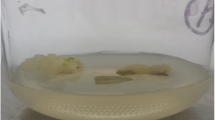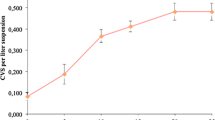Abstract
Nitrogen and light are critical determinants of biomass accumulation and secondary metabolite production under in vitro culture conditions. In this study, we analyzed the effects of varied concentrations of total nitrogen in Murashige and Skoog (MS) medium and light intensity on the production of biomass, anthocyanin pigments, and bioactive antioxidants in callus cultures of Abelmoschus esculentus cv. ‘Hongjiao’. Maximum callus biomass accumulation (3 g FW) was achieved when calluses were cultured on MS medium containing 60 mM nitrogen under 40 μmol m− 2 s− 1 light intensity. In contrast, maximum values of total anthocyanin accumulation (TA; 7.3 CV/g FW), total phenolic content (TP; 12.07 mg/100 g FW), total flavonoid content (TF; 2.47 ± 0.15 mg/100 g FW), and total antioxidant activity (TAA; 56.10 μmol Trolox/g FW) were observed when calluses were cultured on MS medium containing 40 mM total nitrogen under 80 μmol m− 2 s− 1 light intensity. In addition, callus grown under same culture condition exhibited high flavonoid content along with increased phenolic content and antioxidant activity. High performance liquid chromatography (HPLC) was performed for qualitative and quantity analysis of callus cultures. Most of the pigments from the callus extracts were identical with pod anthocyanins, and appeared on the ODS-column HPLC with lower concentration than the main pigments of the pod tissues. These findings indicate that callus cultures of red-pod okra represent a potential source of bioactive compounds with antioxidant properties for industrial applications.




Similar content being viewed by others
References
Ahmad N, Abbasi BH, Rahman IU, Fazal H (2013) Piper nigrum: micropropagation, antioxidative enzyme activities, and chromatographic fingerprint analysis for quality control. Biotechnol Appl Biochem 169: 2004
Ahmad N, Abbasi BH, Fazal H, Khan MA, Afridi MS (2014) Effect of reverse photoperiod on in vitro regeneration and piperine production in Piper nigrum L. C R Biol 337:19–28
Ali M, Abbasi BH (2014) Light-induced fluctuations in biomass accumulation, secondary metabolites production and antioxidant activity in cell suspension cultures of Artemisia absinthium L. J Photochem Photobiol B: Biol 140:223–227
Ali M, Mujib A, Tonk D, Zafar N (2017) Plant regeneration through somatic embryogenesis and genome size analysis of Coriandrum sativum L. Protoplasma 254:343–352
Bagchi D, Sen C, Bagchi M, Atalay M (2004) Anti-angiogenic, antioxidant, and anti-carcinogenic properties of a novel anthocyanin-rich berry extract formula. Biochemistry 69:75–80
Benzie IF, Strain JJ (1996) The ferric reducing ability of plasma (FRAP) as a measure of “antioxidant power”: the FRAP assay. Anal Biochem 239:70–76
Betsui F, Tanaka-Nishikawa N, Shimomura K (2004) Anthocyanin production in adventitious root cultures of Raphanus sativus L. cv. Peking Koushin. Plant Biotechnol 21:387–391
Blando F, Scardino A, De Bellis L, Nicoletti I, Giovinazzo G (2005) Characterization of in vitro anthocyanin-producing sour cherry (Prunus cerasus L.) callus cultures. Food Res Int 38:937–942
Bongue-Bartelsman M, Phillips D (1995) Nitrogen stress regulates gene expression of enzymes in the flavonoid biosynthetic pathway of tomato. Plant Physiol Biochem 33:539–546
Bryant JP, Chapin FS III, Klein DR (1983) Carbon/nutrient balance of boreal plants in relation to vertebrate herbivory. Oikos 357–368
Chan L, Koay S, Boey P, Bhatt A (2010) Effects of abiotic stress on biomass and anthocyanin production in cell cultures of Melastoma malabathricum. Biol Res 43:127–135
Chang C-C, Yang M-H, Wen H-M, Chern J-C (2002) Estimation of total flavonoid content in propolis by two complementary colorimetric methods. J Food Drug Anal 10:33–40
Galbiati M, Chiusi A, Peterlongo P, Gavazzi G, Mancinelli A (1994) Photoinduction of anthocyanin in maize; a genetic approach. Maydica 39:89–95
Irshad M, Shuang L, Bezhu H, Debnath S, Min L, Rizwan HM, Dongliang Q (2017) In vitro regeneration of Abelmoschus esculentus L. cv. Wufu: influence of anti-browning additives on phenolic secretion and callus formation frequency in explants. Hortic Environ Biotechnol 58:503–513
Jenkins GI, Christie JM, Fuglevand G, Long JC, Jackson JA (1995) Plant responses to UV and blue light: biochemical and genetic approaches. Plant Sci 112:117–138
Ji X-H, Wang Y-T, Zhang R, Wu S-J, An M-M, Li M, Wang C-Z, Chen X-L, Zhang Y-M, Chen X-S (2015) Effect of auxin, cytokinin and nitrogen on anthocyanin biosynthesis in callus cultures of red-fleshed apple (Malus sieversii f. niedzwetzkyana). Plant Cell Tissue Organ Cult 120:325–337
Karuppusamy S (2009) A review on trends in production of secondary metabolites from higher plants by in vitro tissue, organ and cell cultures. J Med Plants Res 3:1222–1239
Khvatkov P, Chernobrovkina M, Okuneva A, Shvedova A, Chaban I, Dolgov S (2015) Callus induction and regeneration in Wolffia arrhiza (L.) Horkel ex Wimm. Plant Cell Tissue Organ Cult 1:263–273
Konczak-Islam I, Yoshinaga M, Nakatani M, Terahara N, Yamakawa O (2000) Establishment and characteristics of an anthocyanin-producing cell line from sweet potato storage root. Plant cell Rpt 19:472–477
Lillo C, Lea US, Ruoff P (2008) Nutrient depletion as a key factor for manipulating gene expression and product formation in different branches of the flavonoid pathway. Plant Cell Environ 31:587–601
Liu W, Zhu D-W, Liu D-H, Geng M-J, Zhou W-B, Mi W-J, Yang T-W, Hamilton D (2010) Influence of nitrogen on the primary and secondary metabolism and synthesis of flavonids in Chrysanthemum morifoliun Ramat. J Plant Nutr 33:240–254
Lu Y, Zhang M, Meng X, Wan H, Zhang J, Tian J, Hao S, Jin K, Yao Y (2015) Photoperiod and shading regulate coloration and anthocyanin accumulation in the leaves of malus crabapples. Plant Cell Tissue Organ Cult 121:619–632
Marschner H, Rimmington G (1988) Mineral nutrition of higher plants. Plant Cell Environ 11:147–148
Mulabagal V, Ngouajio M, Nair A, Zhang Y, Gottumukkala AL, Nair MG (2010) In vitro evaluation of red and green lettuce (Lactuca sativa) for functional food properties. Food Chem 118:300–306
Murashige T, Skoog F (1962) A revised medium for rapid growth and bio assays with tobacco tissue cultures. Physiol Plant 15:473–497
Nakamura M, Takeuchi Y, Miyanaga K, Seki M, Furusaki S (1999) High anthocyanin accumulation in the dark by strawberry (Fragaria ananassa) callus. Biotechnol Lett 21:695–699
Narayan M, Venkataraman L (2002) Effect of sugar and nitrogen on the production of anthocyanin in cultured carrot (Daucus carota) cells. J Food Sci 67:84–86
Pandino G, Meneghini M, Tavazza R, Lombardo S, Mauromicale G (2016) Phytochemicals accumulation and antioxidant activity in callus and suspension cultures of Cynara scolymus L. Plant Cell Tissue Organ Cult 1:223–230
Peng M, Hudson D, Schofield A, Tsao R, Yang R, Gu H, Bi Y-M, Rothstein SJ (2008) Adaptation of Arabidopsis to nitrogen limitation involves induction of anthocyanin synthesis which is controlled by the NLA gene. J Exp Bot 59:2933–2944
Ram M, Prasad K, Kaur C, Singh S, Arora A, Kumar S (2011) Induction of anthocyanin pigments in callus cultures of Rosa hybrida L. in response to sucrose and ammonical nitrogen levels. Plant Cell Tissue Organ Cult 104:171–179
Ram M, Prasad K, Singh S, Hada B, Kumar S (2013) Influence of salicylic acid and methyl jasmonate elicitation on anthocyanin production in callus cultures of Rosa hybrida L. Plant Cell Tissue Organ Cult 3:459–467
Reay PF, Fletcher RH, Thomas V (1998) Chlorophylls, carotenoids and anthocyanin concentrations in the skin of ‘Gala’apples during maturation and the influence of foliar applications of nitrogen and magnesium. J Sci Food Agric 76:63–71
Roy A, Shrivastava SL, Mandal SM (2014) Functional properties of Abelmoschus esculentus L.(Moench): traditional claims and scientific evidences. Plant Science Today 1:121–130
Satish L, Rameshkumar R, Rathinapriya P, Pandian S, Rency AS, Sunitha T, Ramesh M (2015) Effect of seaweed liquid extracts and plant growth regulators on in vitro mass propagation of brinjal (Solanum melongena L.) through hypocotyl and leaf disc explants. J Appl Phycol 27:993–1002
Schäfer E, Nagy F (2006) Photomorphogenesis in plants and bacteria: function and signal transduction mechanisms. Springer Science Business Media, Dordrecht
Simões C, Bizarri CHB, da Silva Cordeiro L, de Castro TC, Coutada LCM, da Silva AJR, Albarello N, Mansur E (2009) Anthocyanin production in callus cultures of Cleome rosea: modulation by culture conditions and characterization of pigments by means of HPLC-DAD/ESIMS. Plant Physiol Biochem 47:895–903
Simões C, Albarello N, Castro T, Mansur E (2012) Production of anthocyanins by plant cell and tissue culture strategies. Biotechnological production of plant secondary metabolites. Bentham Science Publishers 40:67–86
Singleton V, Rossi JA (1965) Colorimetry of total phenolics with phosphomolybdic–phosphotungstic acid reagents. J Enol Vitic 16:144–158
Song JY, Lee JS, An CS (1998) Expression of CHS, CHI, and DFR genes in response to light in small radish seedlings. J Plant Biol 41:277–282
Stintzing FC, Carle R (2004) Functional properties of anthocyanins and betalains in plants, food, and in human nutrition. Trends Food Sci Technol 15:19–38
Sudha G, Ravishankar G (2003) Influence of putrescine on anthocyanin production in callus cultures of Daucus carota mediated through calcium ATPase. Acta Physiol Plant 1:69–75
Tanaka Y, Sasaki N, Ohmiya A (2008) Biosynthesis of plant pigments: anthocyanins, betalains and carotenoids. Plant J 54:733–749
Tariq U, Ali M, Abbasi BH (2014) Morphogenic and biochemical variations under different spectral lights in callus cultures of Artemisia absin Toguri T, Umemoto N, Kobayashi O & Ohtani T (1993) Activation of anthocyanin synthesis genes by white light in eggplant hypocotyl tissues, and identificati thium L. J Photochem Photobiol B: Biol 130:264–271
Treutter D (2010) Managing phenol contents in crop plants by phytochemical farming and breeding—visions and constraints. Int J Mol Sci 11:807–857
Wang N, Zhang Z, Jiang S, Xu H, Wang Y, Feng S, Chen X (2016) Synergistic effects of light and temperature on anthocyanin biosynthesis in callus cultures of red-fleshed apple (Malus sieversii f. niedzwetzkyana). Plant Cell Tissue Organ Cult 1:217–227
Yamakawa T, Kato S, Ishida K, Kodama T, MINODA Y (1983) Production of anthocyanins by Vitis cells in suspension culture. Agric Biol Chem 47:2185–2191
Zafra S, Yasmin T, Bagchi M, Chatterjee A, Vinson JA, Bagchi D (2007) Berry anthocyanins as novel antioxidants in human health and disease prevention. Mol Nutr Food Res 51:675–683
Zamir R, Khalil SA, Ahmad N, Rab A, Shah ST, Jabeen N, Ali S, Ali M (2016) The synergistic effects of sucrose and plant growth regulators on morphogenesis and evaluation of antioxidant activities in regenerated tissues of Caralluma tuberculata. Acta Physiol Plant 8:1–9
Zhang W, Furusaki S (1997) Regulation of anthocyanin synthesis in suspension cultures of strawberry cell by pH. Biotechnol Lett 19:1057–1061
Zhang W, Curtin C, Kikuchi M, Franco C (2002) Integration of jasmonic acid and light irradiation for enhancement of anthocyanin biosynthesis in Vitis vinifera suspension cultures. Plant Sci 162:459–468
Acknowledgements
The financial assistance from the FAFU scholarship program, provided by the Fujian Agriculture and Forestry University of China, is gratefully acknowledged.
Author information
Authors and Affiliations
Contributions
MI designed and carried out all the experiments, prepared the manuscript, BD helped in performing the experiments, MS helped in statistical analysis and revised the manuscript, YA helped in HPLC analysis, ML and YT helped in performing biochemical analysis, DLQ conceived the work, revised and finalized the manuscript.
Corresponding author
Ethics declarations
Conflict of interest
No authors have pertinent conflicts of interest to disclose.
Additional information
Communicated by Sergio J. Ochatt.
Rights and permissions
About this article
Cite this article
Irshad, M., Debnath, B., Mitra, S. et al. Accumulation of anthocyanin in callus cultures of red-pod okra [Abelmoschus esculentus (L.) Hongjiao] in response to light and nitrogen levels. Plant Cell Tiss Organ Cult 134, 29–39 (2018). https://doi.org/10.1007/s11240-018-1397-6
Received:
Accepted:
Published:
Issue Date:
DOI: https://doi.org/10.1007/s11240-018-1397-6




